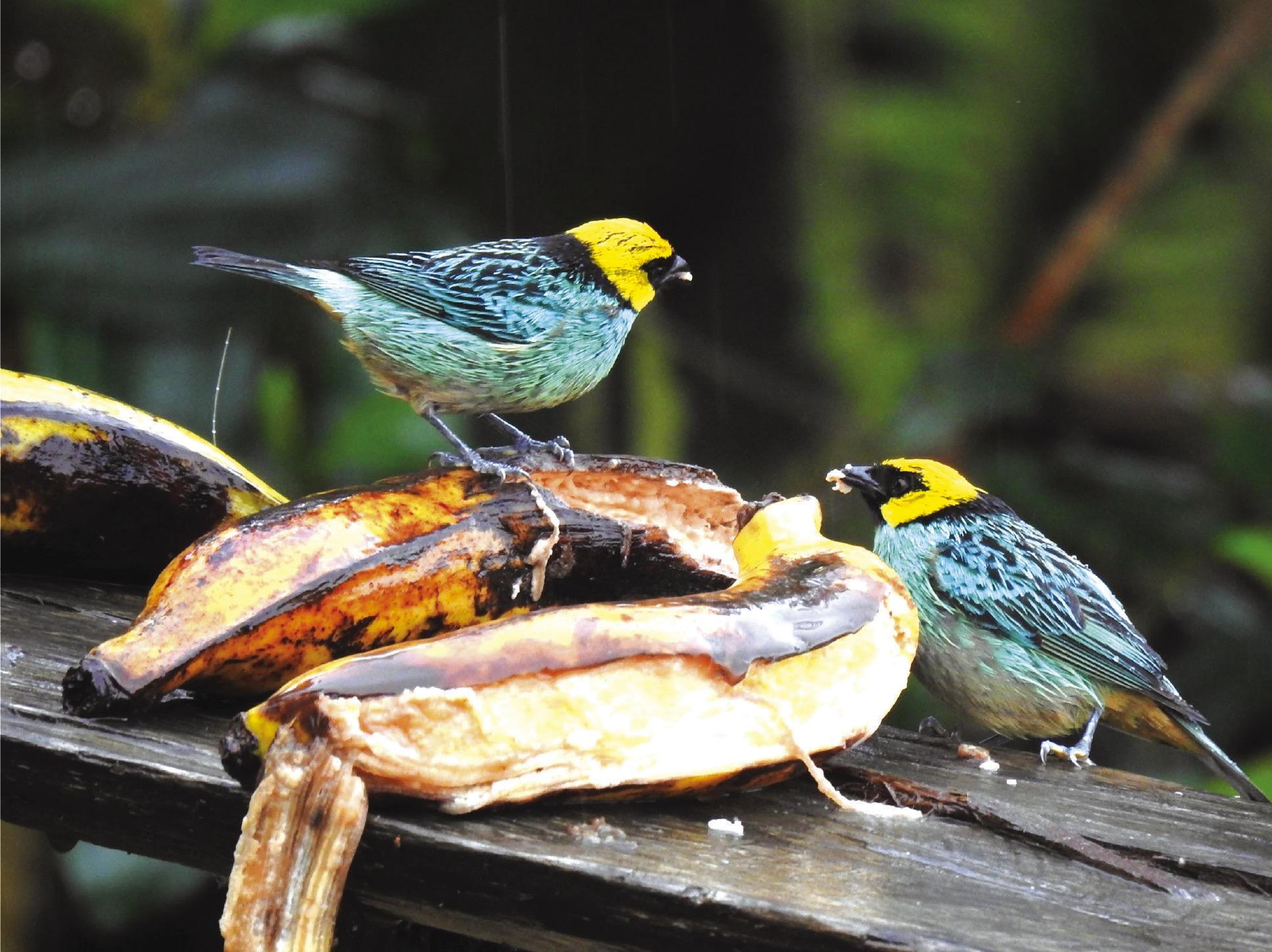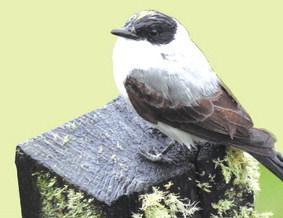
A pair of Saffron-headed Tanagers share a little lunch near a small restaurant along the Jardin-Riosucio route. It is still a long way to get to Mirador Roble if you are walking, so consider the afternoon bus from Jardin to get there if finding Tapaculo and Antpitta is your principal objective.
Photos by Justin Harris


Visitors will encounter many bird species, like this Fork-tailed Flycatcher.
Into the Clouds
Off the Beaten Path
May 14, 2023: Riosucio, Antioquia — Caldas, Columbia
Normally, I prefer not to use guiding services when looking for birds. Apart from costing more money, you also aren’t as free to go at your own pace if there is a time limit. Nevertheless, in a country as massive and biodiverse as Colombia, there are certain situations — and certain species — for which using a guide is the best bet. I encountered such a situation on my second visit to Jardin — which I mentioned in the previous ‘Into the Clouds’ article — when I returned in May of 2023. As anticipated, I encountered the Andean Cock-of-the-Rock again, and it was definitely a reunion fitting the occasion. I also knew, though, that South America’s cloud forests contained within them many dark and hidden corners. This is a region known for its undergrowth, a tangled network and maze of thick vegetation. There are many bird species to be found here as well, but they are hardly as raucous and as boisterous as a Cock-of-the-Rock. They are shy, retiring creatures that will hunker down at the slightest crunch of a leaf or snap of a twig. Unless you are truly an expert birder — which I am most certainly not — then it will be very difficult to find them absent the services of an experienced local guide.
Fortunately, at Mirador Roble — as at many other birding lodges in Colombia — these services need not break the bank. On the recommendation of my AirBnB host in Jardin, I reserved two days and one night for around 15,000 Colombian Pesos, or 40 US dollars. This included a bed in a private room, four meals and some truly incredible bird encounters.
Don’t expect luxury accommodation and see this as an opportunity to embrace. Also: dress warmly. Colombia may be near the equator, but at this altitude, it will get chilly at night.
To get to Mirador Roble from Jardin, you have three options. You can take an extremely long walk, a tuk-tuk or grab the bus that runs once or twice per day. I chose the third option.
The stretch of cloud forest between Jardin and the bus’ final destination — Riosucio — is an immense trail in which there is practically no limit to the number of bird species that you can see. As you stop off at Mirador Roble, these will include hundreds of Yellow-Eared Parrots. Take the time to cherish this moment, because this species had been considered extinct prior to its rediscovery in 1999. Like the Cockof- the-Rock, they are a primary draw for birders who come to Jardin. You can also take a tour from Jardin to see them, which I had done in 2022.
But even Yellow-Eared Parrots were not the reason I came to Mirador Roble this time. It was the birds of the undergrowth. Upon my arrival, there were already some hummingbirds at the feeder, including a male Long-Tailed Sylph, which has a tail greater than the length of its body. These, and a curious Chestnut-Naped Brushfinch — which ate some bird seed right from my hand — kept me busy. The next morning, though, it was time to get down to business. The owner had filled my stomach with a basic, yet fulfilling local breakfast, and her son was ready to roll.
With that, I hopped on the back of his motorcycle and we peddled for a few minutes. Stopping off at an area across from where the Yellow-Eared Parrots congregated, we left the motorcycle and proceeded about 20 minutes down a dark trail, until we came to a gazebo-like structure. He opened up a pail, which had some worms inside that we would use for bait. Opening his Merlin app — a valuable tool in identifying and attracting birds — he began playing a shrieking call. Within seconds, a bizarre-looking creature hopped into the foreground, seemingly from nowhere. It looked almost like a plump potato on two long, stick-like legs.
There are nearly 70 species of Antpitta in the world, of which Colombia is host to nearly 30 — more than any other country in the world. This was a Chestnut- naped Antpitta. An ochre brownish color on top and a slaty gray color on the breast made for a remarkably striking creature. While bringing an Antpitta out from the undergrowth was not always an easy task, my guide had certainly made it look like one. The bird came close, and showed no hesitancy when it came to eating earthworms right from the palms of our hands. The Antpitta stayed for close to 10 minutes before disappearing into its dense, nearly impenetrable lair. The excitement, however, was not quite over yet.
In between meeting the Antpitta and lunch, we caught some mixed species flocks on the way back to Mirador Roble: Woodcreepers, Tanagers and Caciques, a relative of blackbirds and orioles. You name it; we ran into it.
Following lunch, we walked down a trail into a small patch of forest that was home to our next target, a species even more shy and elusive than an Antpitta. Despite the worms and the Merlin playback, this was one bird of the cloud forest undergrowth that wasn’t going to reveal itself so easily. Finally, after 20 minutes of effort — and a lot of mosquito bites — it began responding. Tepidly, it came closer and closer until finally, it was there in all of its stunning glory.
Like Antpitta, Ocellated Tapaculo are shy and stealthy ground dwellers. The plump bird, which was about eight inches long, sported an incredible coat of spotted feathers that would make even the most famed fashion designer glisten with sheer envy. Its huge eyes were perfectly equipped for finding and capturing prey in this dimly lit habitat. For the next half hour, we sat crouching as the Tapaculo repeated the same cycle. It would go back to its starting point, slowly make its way towards us, grab one of our worms, unleash its shrilling call and repeat. For myself — as with any birder — it was a reward well worth waiting for. If you revel in nature and you wish to visit Colombia, I believe that you ought to come to Jardin-Riosucio and Mirador Roble in order to do the same. You will not regret it.
Justin Harris is a teacher, world traveler, wildlife photographer, nature enthusiast and citizen-scientist.
This article is the final part in a three-part series about travel in Colombia.











